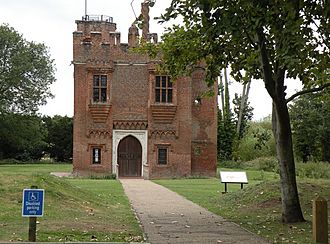Rye House, Hertfordshire facts for kids
Quick facts for kids Rye House, Hertfordshire |
|
|---|---|

The gatehouse of Rye House (2009), the only surviving part of the manor house
|
|
| General information | |
| Location | Lee Valley Park, Hoddesdon |
| Coordinates | 51°46′16″N 0°00′25″E / 51.7711°N 0.007°E |
| Construction started | c.1443 |
Rye House is an old fortified manor house located in Hoddesdon, Hertfordshire. Today, only its impressive gatehouse remains. This gatehouse is a very important historic building, known as a Grade I listed building. Rye House is famous because it gave its name to the Rye House Plot in 1683. This was a plan to assassinate King Charles II and his brother, James. It was a violent event linked to political problems in Britain during the late 1670s.
Contents
History of Rye House
Rye House was owned by the same families for over 400 years. However, over time, the building slowly fell into disrepair, and parts of it disappeared.
Building the House
In 1433, a Danish soldier named Andres Pedersen became an English citizen and was known as Sir Andrew Ogard. In 1443, he was given permission to create a park around his home, which was then called the Isle of Rye. He also received a special permission, called a licence to crenellate, to build a fortified house. This meant he could add battlements and defenses to his home, making it look like a castle. Over 50 different types of specially shaped bricks were used to build Rye House.
Later Years and the Plot
In 1517, William Parr lived at Rye House. It was the main home for his family, including his sisters Catherine Parr and Anne Parr, until 1531. Later, in 1577, the house was passed to Joyce Frankland. Her family then sold it to the Baeshe family in 1619.
Rye House became famous as the setting for the Rye House Plot in 1683. At that time, a man named Richard Rumbold, who was one of the plotters, lived there. The plot was a secret plan to assassinate King Charles II and his brother, James, Duke of York. The Fieldes family bought the house in 1676. A short film about the Rye House Plot was even made in the late 1920s.
Rye House as a Tourist Spot
By 1834, Rye House was being used as a workhouse, a place where poor people could live and work. Later, in 1864, a man named Henry Teale bought the house and 50 acres of land. He turned it into a popular tourist attraction. Visitors could enjoy a maze, a bowling green, and other fun features.
In 1885, there was a small fight at Rye House between two groups of people on an outing. This event was even discussed in the House of Commons, which is part of the British Parliament. By 1911, Rye House was known as a hotel. For many years, a very famous and huge bed, called the Great Bed of Ware, was on display there.
The moat around the house, which is a deep, wide ditch, was used for different things, like growing water cress. Parts of the moat that had been filled in were dug out again in the 1980s.
Geography of the Area
The location of Rye House was very important to its history. It is situated where the River Stort flows into the River Lea near Hoddesdon. This area often experienced floods. The owner of Rye House was responsible for maintaining a bridge over the River Lea and a raised path called a causeway. This causeway later became part of a main road that coaches used to travel to East Anglia.
Images for kids
-
A watercolour painting from 1793 by the famous artist J. M. W. Turner.







